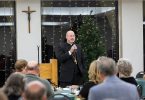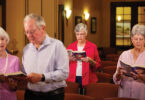
by Olivia Martin
olivia.martin@theleaven.org
KANSAS CITY, Kan. — Go to daily Mass anywhere in the world, and what will you find?
A priest — of course.
An altar server — sometimes.
A predominantly female congregation — absolutely.
Since ancient times, women have been at the heart of the life of the church. More recently, women don’t just head up altar societies, outreach ministries and funeral dinners, they keep the parish running — increasingly from professional positions within the church.
“In fact,” said Msgr. Tom Tank, pastor of Church of the Ascension in Overland Park, “the parish would be terribly, terribly hampered and inactive without all of the women who are involved.”
Learning to work together
For newly ordained priests moving from an all-male seminary to working closely with women in the parish, the transition can be quite a task.
“I’ve got no males I work with,” said Father Nathan Haverland, pastor of St. Gregory Parish in Marysville. “Going from that all-male environment to all-female was a major adjustment.”
Father Jaime Zarse, pastor of Sacred Heart in Sabetha, St. Augustine in Fidelity and St. James in Wetmore, agreed. However, time in seminary helped prepare for exactly that: working with women.
While attending Kenrick-Glennon Seminary in St. Louis, Father Zarse took a course on women in the church. It covered St. John Paul II’s 1988 letter to women called “Mulieris Dignitatem” and the works of many great Catholic women thinkers, including St. Teresa of Avila, St. Thérèse of Lisieux and Edith Stein (St. Teresa Benedicta).
“That class was huge!” said Father Zarse. And one of the reasons it was so impactful, he said, was because it was taught by a woman.
“The truth is, I myself did not bond especially well with my mom growing up,” said Father Zarse. “We had a good relationship, but we were not super close by any stretch of the imagination.”
But that class helped him approach women in a new way — not as a threat, but as a blessing.
Father Zarse found a class taught by a female Catholic psychologist and counselor to be of great formative value as well.
“[Dr. Suzanne Harvath’s] class was basically designed to help teach us future priests how to navigate boundaries with women in a way that was not going to hurt them or make them feel like they’re nothing more than a threat to our vocation,” said Father Zarse.
“Again, being taught by a female psychologist was so helpful,” he added.
And Father Zarse wasn’t the only one who found it so.
Five years after leaving the seminary, he and his classmates participated in an email thread taking the temperature of their adjustment to life in the priesthood.
“Everyone said the most helpful class we took in theology was not Scripture or dogmatic or systematic theology,” he said. “It was actually Dr. Harvath’s pastoral counseling class because it was so concrete.”
Women as professional support
After newly ordained priests make the adjustment from seminary to parish life, they find the input and perspective of women colleagues to be invaluable.
Msgr. Tank entered the seminary at 14 years old and stayed until his ordination. And while he was not professionally engaged with women during that time, he found the step to working closely with them an easy one.
“[The women I work with] bring a . . . compassion to their work,” said Msgr. Tank. “In some ways, they soften me and in some ways, they say, ‘Father, you need to get a little tougher!’’’
Women Father Zarse works with in Sabetha, from a parishioner who pushes him to exercise to Enflame delegates, have been central to his ability to live his priestly vocation well, especially during a year of “firsts” — as a pastor and as a small-town resident.
Gina Sallman, Sacred Heart’s DRE, lead catechist, bookkeeper and administrative assistant, grew up in the city and moved to Sabetha, like Father Zarse, and she’s used her experience to help him adjust.
“She’s been such a gift for me,” said Father Zarse, “because it’s such a culture shock for a city boy to move into the country for the first time!”
Father Haverland has been struck as well by the atmosphere of inclusivity women he works with bring to the workplace in the parish.
“I think they bring a great complementarity and they help me be a better priest,” he said.
Overwhelmed with gratitude, Father Zarse has a special place in his heart for the women he works with.
“Jesus has given me these four women not only to help me exercise my priestly ministry in a way that is structured, organized and well thought-out, but also to take care of myself,” he said.
Building a culture of respect
Respect and recognition for women’s gifts in the church doesn’t stop with him, said Father Zarse.
Father Haverland works to make sure that the gifts of women are reflected and included in parish boards.
“I always try to have an even amount [of men and women],” said Father Haverland. “No question that there should be equal representation.”
And the key to appreciating the strengths and perspectives of women in the parish and beyond lies somewhere very specific for Father Zarse.
“I really believe that the strength of every man lies in the heart of the woman he loves,” he said. “Our Lady is the most important woman in my life, and I feel Our Lady’s heart is shining through these women I work with.”
But it’s not always easy.
“I’ll be honest, it’s hard as a priest,” said Father Zarse. “The world is full of so many beautiful women. On one hand, you really do have to guard your heart and on the other hand, you really need to work with them.”
The witness of the goodness and faithfulness of the women he works with keeps Father Zarse striving for greatness.
“They make me want to be holy,” he said.






